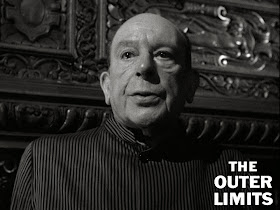Season 5, Episode 9 (129 overall)
Originally aired 11/29/1963
Cayuga Production # 2622
Fifty years ago tonight, viewers received a measured dose of interplanetary déjà vu, courtesy of The Twilight Zone.
 Rod Serling’s “Probe 7, Over and Out” introduces us to Colonel Adam Cook, whose spacecraft has crashed into an unknown planet. He manages to establish visual contact with his superiors back home, who give him the unfortunate news that all-out war is imminent, and that their world is doomed. Stranded with no hope of rescue, he ventures outside into the lush, unspoiled garden-like forest…. and discovers that he’s not alone.
Rod Serling’s “Probe 7, Over and Out” introduces us to Colonel Adam Cook, whose spacecraft has crashed into an unknown planet. He manages to establish visual contact with his superiors back home, who give him the unfortunate news that all-out war is imminent, and that their world is doomed. Stranded with no hope of rescue, he ventures outside into the lush, unspoiled garden-like forest…. and discovers that he’s not alone.  Another stranded space traveler, Eve, greets him with a rock to the head and a scratch across the face. After these initial hostilities (foreplay?), she warms up to him and they head off into the sunset together. Sound familiar? Have we perhaps seen this story played out before? You could cite the Book of Genesis, but you’d only be half right.
Another stranded space traveler, Eve, greets him with a rock to the head and a scratch across the face. After these initial hostilities (foreplay?), she warms up to him and they head off into the sunset together. Sound familiar? Have we perhaps seen this story played out before? You could cite the Book of Genesis, but you’d only be half right.
“Probe 7, Over and Out” is a shameless copy of season three’s “Two,” right down to the verbose male lead and the black around the female’s eyes. The only significant difference is that this swipe at the laughable Adam and Eve cliché is that here, in this second pass, there’s virtually no attempt at subtlety (she even offers him an apple, fer chrissakes!). “Two” was wise enough not to go there; but then, that (superior) episode wasn’t written by Serling.
We can also thank Serling for Cook’s endless philosophical musings on the nature of man, which I’d be a bit more accepting of if at least some of them were done in voiceover; as it stands, Cook’s constant talking to himself just feels clumsy and awkward (season two’s “King Nine Will Not Return,” also written by Serling, is helped immeasurably by the voiceover approach).
“Probe 7, Over and Out” is fine enough on a visual/technical level, thanks largely to the impressive life-sized spacecraft. The wrecked ship was purchased from Daystar Productions, which had built it for the Outer Limits episode “Specimen: Unknown.” Its image was also was inexplicably used by Bif Bang Pow! on the card backs of their 2012 TZ action figures, even though they've never produced any collectibles based on this episode (and they sure as hell haven’t produced any Outer Limits stuff, despite my incessant begging).
“Probe 7, Over and Out” is fine enough on a visual/technical level, thanks largely to the impressive life-sized spacecraft. The wrecked ship was purchased from Daystar Productions, which had built it for the Outer Limits episode “Specimen: Unknown.” Its image was also was inexplicably used by Bif Bang Pow! on the card backs of their 2012 TZ action figures, even though they've never produced any collectibles based on this episode (and they sure as hell haven’t produced any Outer Limits stuff, despite my incessant begging).
THE MUSIC
Most of the underscore in “Probe 7, Over and Out” is culled from Jerry Goldsmith’s “Back There” score from season two. These cues were used to great effect in season three’s “To Serve Man”; here, however, they sound a bit out of place (“Uncle Simon” suffered a similar problem). “The Outer Space Suite,” or maybe “Where is Everybody?” (both by Bernard Herrmann) would've probably worked better. I guess I should be grateful they didn't use Nathan Van Cleave’s “Two” score…!
FAMILIAR FACES
Richard Basehart (Adam Cook) is probably best remembered for his role as Admiral Harriman Nelson on TV’s Voyage to the Bottom of the Sea (1964-68). IMDB lists an uncredited role as “Shakespeare-Reading Tape Recorder Voice” on an episode of Lost in Space (“The Derelict”); I’m only mentioning it because of the many connections shared by TZ and Lost in Space (Robby the Robot's fraternal twin the B-9 Robot, Billy Mumy, Jonathon Harris, etc).
 Antoinette Bower (Eve Norda) is probably most recognizable to genre fans as Sylvia in the “Catspaw” episode of the original Star Trek; however, Bower appeared on many genre TV series throughout the 60’s and 70’s (including Mission: Impossible, The Invaders, and The Six Million Dollar Man).
Antoinette Bower (Eve Norda) is probably most recognizable to genre fans as Sylvia in the “Catspaw” episode of the original Star Trek; however, Bower appeared on many genre TV series throughout the 60’s and 70’s (including Mission: Impossible, The Invaders, and The Six Million Dollar Man).
My overall analysis of “Probe 7, Over and Out” can be boiled down to six words: been there, done that, over, out.
Next week:
War games are afoot, but Matthew Broderick is nowhere to be found.























































